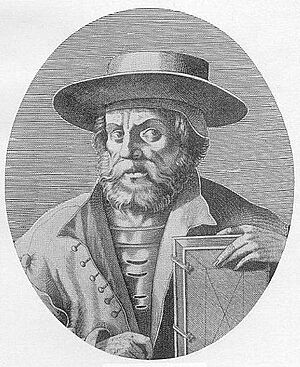Manuel Chrysoloras facts for kids
Quick facts for kids
Manuel Chrysoloras
|
|
|---|---|

Manuel Chrysoloras portrayed by Paolo Uccello in 1408. Drawing currently preserved in the Louvre Museum, Paris.
|
|
| Born | c. 1350 |
| Died | 15 April 1415 |
| Nationality | Byzantine Greek |
| Occupation | Diplomat, educator, scholar, and professor |
| Years active | 1390 – 1415 |
| Known for | Translating works of Homer, Aristotle, and Plato into Latin |
|
Notable work
|
Erotemata Civas Questiones |
Manuel Chrysoloras (born around 1350, died 1415) was a very important Greek scholar from the Byzantine Empire. He was a professor, a philosopher, and a translator of old Greek writings during the time known as the Renaissance.
Chrysoloras also worked as an ambassador for the Byzantine emperor Manuel II Palaiologos in medieval Italy. He became a famous teacher of Greek literature and history in cities like Florence and Venice. Many people today see him as a key person who helped bring ancient Greek literature to Western Europe during the Late Middle Ages.
Contents
Manuel Chrysoloras: A Life of Learning
Manuel Chrysoloras was born in Constantinople, which was the capital city of the Byzantine Empire at the time. His family was well-known and belonged to the Greek Orthodox Church.
In 1390, Chrysoloras led a special trip to the Republic of Venice. He was sent by the Byzantine emperor, Manuel II Palaiologos. The emperor wanted to ask Christian leaders in Medieval Europe for help. They needed support against the Muslim Ottoman Turks, who were invading the Byzantine Empire.
In Venice, Chrysoloras met Roberto de' Rossi from Florence. Later, in 1395, Rossi's friend Jacopo d'Angelo traveled all the way to Constantinople. He went there to study Greek with Chrysoloras.
Teaching Greek in Florence
In 1396, Coluccio Salutati, a leader in Florence, invited Chrysoloras to teach Greek grammar and literature there. Salutati wrote a letter saying that both Greeks and Latins (people from Italy) had always learned more by studying each other's literature.
Chrysoloras arrived in Florence in the winter of 1397. One of his most famous students, Leonardo Bruni, remembered this as a huge opportunity. He said that while there were many law teachers, no one had studied Greek in northern Italy for 700 years. Another important student was Ambrogio Traversari, who later became a leader of the Camaldolese religious group.
Chrysoloras only stayed in Florence for a few years, from 1397 to 1400. He taught Greek, starting with the very basics. After Florence, he moved on to teach in Bologna, and then in Venice and Rome.
His Famous Students
Even though he taught in many places, a small group of his chosen students stayed very close. They were among the first humanists of the Renaissance. These students became very important in bringing back Greek studies in Italy.
Besides Bruni, d'Angelo, and Traversari, his students included:
- Guarino da Verona
- Coluccio Salutati
- Roberto Rossi
- Niccolò de' Niccoli
- Carlo Marsuppini
- Pier Paolo Vergerio
- Uberto Decembrio
- Palla Strozzi
and many others.
Later Travels and Works
After visiting Milan and Pavia, and living in Venice for several years, Chrysoloras went to Rome. He was invited by Bruni, who was working for Pope Gregory XII at the time.
In 1408, Chrysoloras was sent to Paris for an important mission from the Byzantine emperor. In 1413, he traveled to Germany as an ambassador to the Holy Roman Emperor Sigismund. Their goal was to choose a place for a church meeting, which later became the Council of Constance.
Chrysoloras was on his way to this council, chosen to represent the Greek Church, when he suddenly died on April 15, 1415. His death led to many essays written in his memory.
Chrysoloras translated important works by Homer, Aristotle, and Plato (like Republic) into Latin. His own writings were passed around as manuscripts during his lifetime. These included short pieces about religious topics and letters to his family and friends.
Two of his works were later printed:
- Erotemata (Questions): This was the first basic Greek grammar book used in Western Europe. It was first published in 1484 and reprinted many times. It was very popular among his students and later scholars like Thomas Linacre and Desiderius Erasmus.
- Epistolæ tres de comparatione veteris et novæ Romæ (Three Letters on the Comparison of Old and New Rome): This compared the cities of Rome and Constantinople.
Many of his writings on morals, ethics, and other philosophical ideas were printed much later, in the 17th and 18th centuries. His biggest impact came from his teaching. He helped people like Leonardo Bruni, Coluccio Salutati, and Guarino da Verona become familiar with the great works of Western philosophy and ancient Greek literature.
See also



